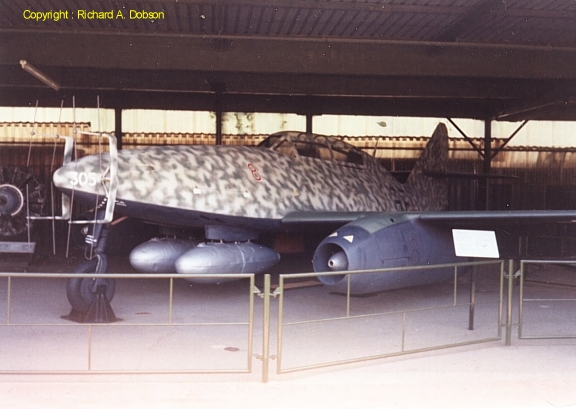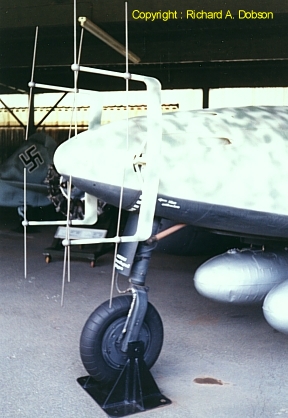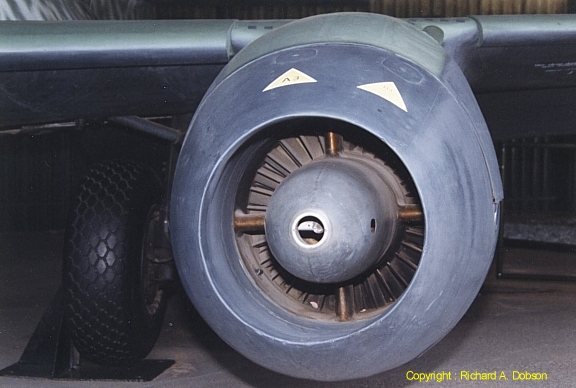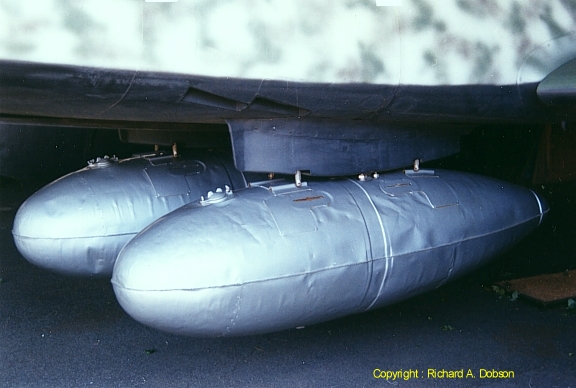German
Luftwaffe WW II
Messerschmitt
Me
262B-1a/U1 Night fighter
In defence of
Berlin
prior to the end of the war the unit was
forced to operate from an
"Autobahn", after the bombing of its
airfield. All of the aircraft were
painted in a locally developed unofficial
camoflage designed to protect
it when parked under the trees at the side
of the road.
To
adapt the
aircraft from its original single seater
version, the two
main fuel tanks in the fuselage were
considerably reduced in
size, and this capacity was replaced by the
two overload tanks
fitted below the centre section, which could
be jettisoned after use,
and before engaging in combat.
Unit: Staffel
10 of Nachtjagderschwader 11, Berlin, April
1945.
Maximum
Speed :
810km per hour
Ceiling:
9250mt
Armament: Four Mk
108 30mm Cannon in the nose
Powerplant:
Two, Junkers Jumo 004B axial-flow turbojets
using J2 Diesel Fuel
Thrust: 900kg
at 9000rpm
Starter: Each
Jumo was fitted with a small two cylinder
"Riedel" two stroke piston
engined starter motor.
The Jumo
engines
were started on 87 octane aviation gasoline, and
automatically changed to J2 Diesel fuel as the
engines reached 3000rpm,
and the throttles were opened further.
 |
Messerschmitt
Me
262B 1a/U1 Night Fighter.
Werk Nommer 110305. The only two seater
night fighter version still in
existence. The aircraft is, "Red 8" of
Staffel 10 of
Nachtjagderschwader 11 which operated
from Burg-bei-Madgeburg, and was
used to defend Berlin in 1945.
|
 |
View
showing
the "Lichtenstein" radar
antennae mounted on the nose of the
aircraft. The aircraft was fitted
with an FuG Neptun Airborne radar,
with which the radar operator would
guide the pilot onto the target.Also
take note of the two cannon ports
just behind the antennae.
|
 |
View
showing the air tintake of the
"Junkers Jumo 004B" turbojet, the
housing of the "Riedel" starter motor
can also be seen.
|
 |
View
of the Port side of the aircraft
showing the four batteries of signal
cartridge flare tubes. A variety
of signal cartridge flares in various
colours were electronically
fired. The main purpose of these flares
was air-to-ground communication.
|
 |
To
adapt the aircraft from its original
single-seater design, the two main
fuel tanks in the feselage were
reduced in size, this capacity was
replaced by two overload tanks which
could be jettisoned after use or
before combat.
|
 |
The
aircrafts locally designed camouflage
pattern was adapted to suit the
temporary surroundings from which
these
aircraft operated. These patterns were
often at variance with the
officially prescribed schemes.
|
Top
|






